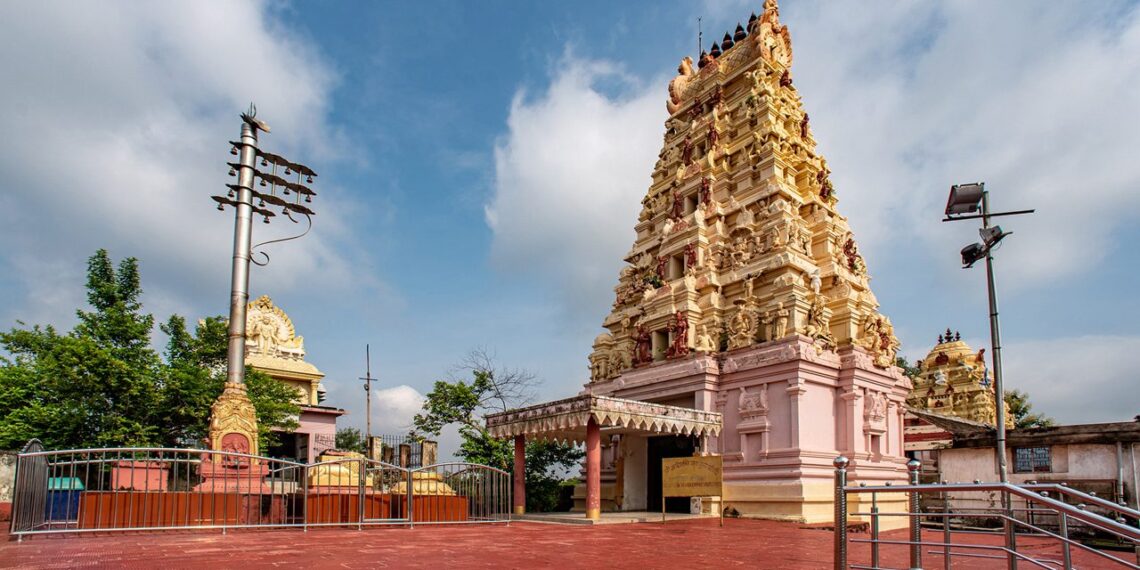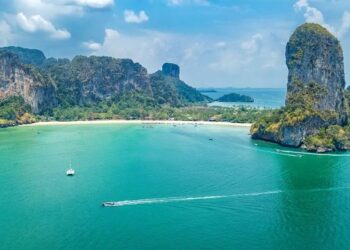Situated in the bustling heart of Telco Colony, Jamshedpur, Jharkhand, the Bhuvaneshwari Temple, also known as Telco Bhuvaneshwari Temple, is a revered shrine of worship dedicated to Goddess Bhuvaneshwari, also known as the queen of the universe. Built in recent times, with construction completed in 1978, this temple is famed for its Dravidian-style architecture and its hilltop serene views of the steel city. It is a magnificent structure along with its five-tiered Rajagopuram (the main entrance tower) standing at a towering height of 64 feet and decorated with 5 Kalasams (spires).
Notable Fact: Perched at 350 feet on Bhuvaneshwari Hill, the temple’s eight pillars are believed to house distinct incarnations of Goddess Bhuvaneshwari.
Overview of Bhuvaneshwari Temple
Bhuvaneshwari Temple stands in Kharangajhar, Telco Colony, 10 km from Jamshedpur’s Tatanagar Junction, a key Hindu pilgrimage site for Shaktism. Known for its 4-foot Bhuvaneshwari idol, the 2-acre complex includes shrines for Krishna, Ayyappa, Hanuman, and Navagraha. Devotees offer flowers, vermilion, and ghee laddus, believing the goddess grants wisdom and strength. Founded by Swami Ranga Rajan Ji Maharaj in 1978, it is managed by a trust, serving 5000–10,000 visitors during Navratri. A spiritual haven, it reflects South Indian heritage in Jharkhand’s industrial hub, with a nearby Guruvayur Temple adding charm.
History of Bhuvaneshwari Temple
Records show the temple was built in 1978 by Swami Ranga Rajan Ji Maharaj, a revered Tamil priest, with support from Tata Steel’s community. No ancient roots exist, as it is a modern shrine inspired by Dravidian traditions, catering to South Indian families in Telco Colony. Local tales claim the hill was chosen for its serene energy, ideal for worship. In 1980, a Krishna temple, founded by Kerala devotees, was added nearby, per Tripadvisor reviews. The trust launched Vedic classes in the 1990s, promoting spiritual learning.
Architecture of Bhuvaneshwari Temple
Bhuvaneshwari Temple, set on a 2-acre hilltop at 350 feet, follows Dravidian architecture with a 64-foot, five-tiered Rajagopuram adorned with five kalasams (spires). The main shrine, 8 meters by 8 meters, is built of granite and white marble, housing a 4-foot Bhuvaneshwari idol. Eight pillars, each 2 meters tall, surround the sanctum, believed to embody the goddess’s incarnations. Smaller shrines, each 3 meters by 3 meters, honor Krishna, Ayyappa, Hanuman, and Navagraha, with colorful gopurams. A 10-meter by 8-meter garden lies west, with no ritual pond. The entrance, a 6-meter-wide arch, bears floral carvings. The tiled yard, 1000 square meters, holds 3000 devotees, accessible by car or 100 steps.
Sculptures of Bhuvaneshwari Temple
The temple’s heart is the 4-foot Bhuvaneshwari idol, black stone, four-armed, holding a lotus and noose, draped in red. Krishna’s 3-foot idol, white marble, plays a flute in the Guruvayur-style shrine. Ayyappa’s 2-foot idol, black stone, holds a bow. Hanuman’s 3-foot idol, red sandstone, carries a mace. Navagraha’s nine 1-foot idols, black stone, align in a row. The Rajagopuram bears 20 carved panels, 0.5 meters by 0.3 meters, depicting Durga’s battles and Krishna’s leelas, painted in red and gold. The arch has two 0.5-meter floral motifs. No ancient sculptures exist, but the 1978 carvings reflect South Indian artistry, vibrant and precise.
Information for Travelers
How to Reach Bhuvaneshwari Temple, Jamshedpur
In Kharangajhar, Telco Colony, 10 km from Tatanagar Junction, the temple is reached by auto, taxi, or bus, set on Bhuvaneshwari Hill.
By Air
Birsa Munda Airport, Ranchi, 130 km away, connects to Delhi (2.5 hours), Kolkata (1.5 hours), Mumbai (2 hours), Bangalore (2.5 hours). Taxis take 3 hours.
By Train
Tatanagar Junction, 10 km away, links to Kolkata (4 hours), Delhi (20 hours), Mumbai (24 hours). Autos from the station to the temple cost ₹60, taking 20 minutes.
By Road
Telco connects to Jamshedpur city center (10 km, 20 minutes), Ranchi (130 km, 3 hours), Dhanbad (150 km, 3.5 hours) via NH-18. State buses cost ₹20–100; private buses run hourly. Taxis cost ₹500–1500. Autos cost ₹20–50, no steps if driven to the gate.
Hours and Entry
Open daily, 7:00 AM–11:30 AM, 5:00 PM–7:00 PM. Free entry; puja costs ₹50–300. No photography in the sanctum. Wear clothing covering shoulders and knees; women wear sarees or suits, men wear kurtas or dhotis.
Best Time to Visit
October to March, temperatures 14–25°C, suits visits. Weekdays see 2000 visitors; weekends, 5000. Navratri (October) and Durga Puja draw 50,000, book early. Avoid April–June, 25–40°C.
Nearby Attractions
Jubilee Park, 8 km, 225-acre park with a zoo.
Dimna Lake, 12 km, picnic spot by Dalma Hills.
Tata Steel Zoological Park, 10 km, 150 animal species.
Dalma Wildlife Sanctuary, 14 km, elephant habitat.
Rankini Mandir, 15 km, ancient Kali temple.
Final Thoughts
Bhuvaneshwari Temple in Jamshedpur, Jharkhand, is a revered temple heritage in India where goddess Bhuvaneshwari’s cosmic grace and the hill’s calm touch them who come, making it a place you must see among India’s holy spots for both devotees and travelers alike.











